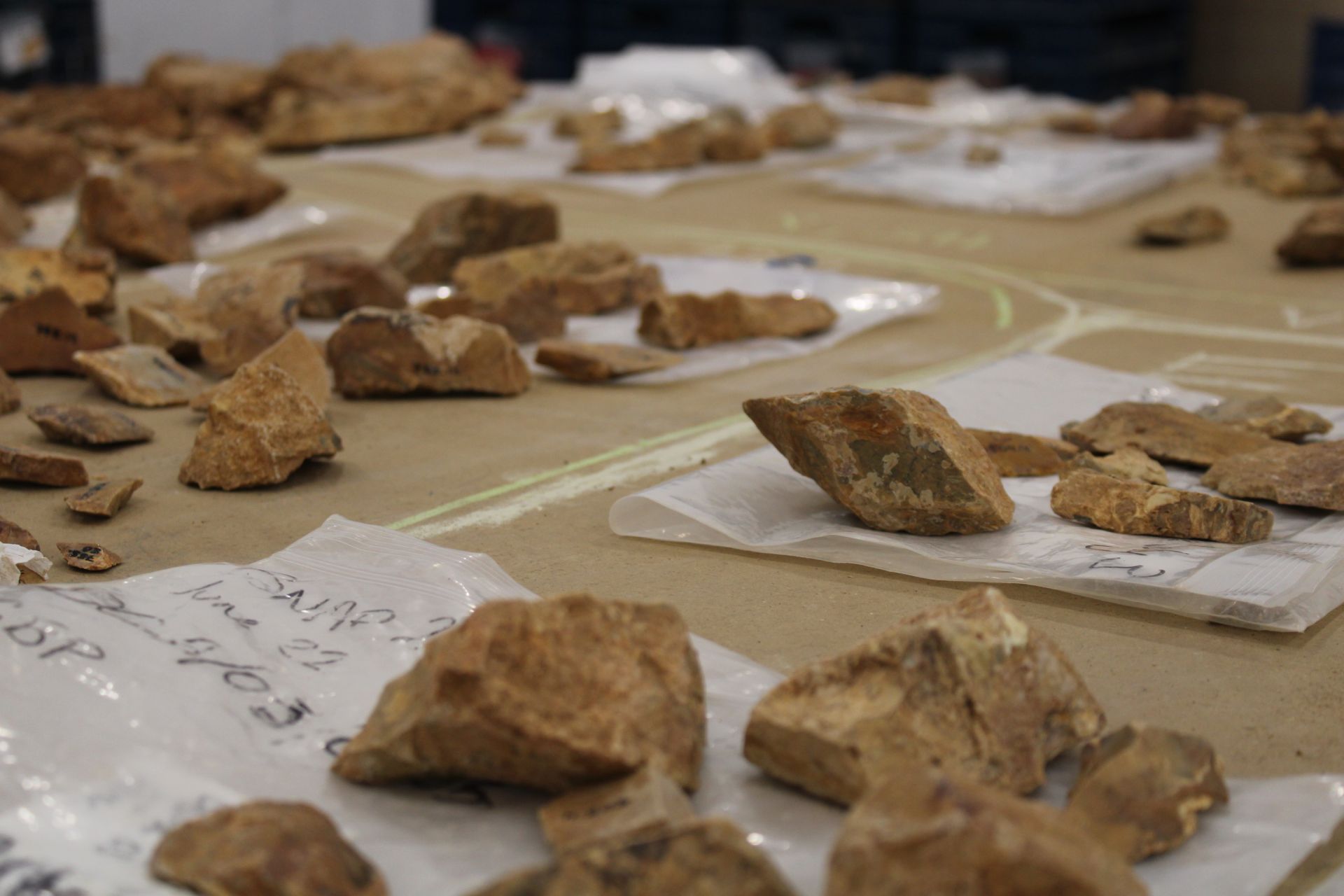In the 1960s, the U.S.-based behavioral scientist Alfred de Grazia bought a large piece of land on Stelida, a remote, scrubby hill on the Greek island of Naxos. He resided there every summer with his French wife Anne-Marie, a poet. The couple lived a quiet, secluded life until one afternoon in 2014, just a couple of weeks after her husband had passed away, Anne-Marie de Grazia peered out of her window to see two stooping figures planting little red flags along the edges of her garden.
After a brief exchange, it transpired that the pair were the archaeologists Tristan Carter and Katie Campeau, who were surveying the land for traces of Neanderthal toolmaking. Excited by the possibility, and in honor of her late husband, who would have been thrilled by the discovery, de Grazia wasted no time in granting the team full authorization to excavate on her property, with the approval of the Greek Ministry of Culture. The encounter would mark the beginning of the Stelida Naxos Archaeological Project, a pioneering dig that is not only rewriting the Neanderthal story, but shrinking the distance between us and them.
It’s long been assumed that island colonization was an exclusively human activity. Only we could build boats and only we had the desire to navigate the oceans. The new finds at Stelida have exposed a weakness in the narrative, however: Modern humans are not supposed to have settled in Europe until around 50,000 years ago, and yet the lithics (tools and other worked stone) found on Naxos hint at island habitation as far back as 200,000 years ago. What’s more, many of these finds bear the hallmarks of Neanderthal craftsmanship, suggesting that the enigmatic hominin reached these islands either around the same time as humans or even before us, toppling our assumption that only modern humans had the navigational nous and curiosity to colonize these islands.
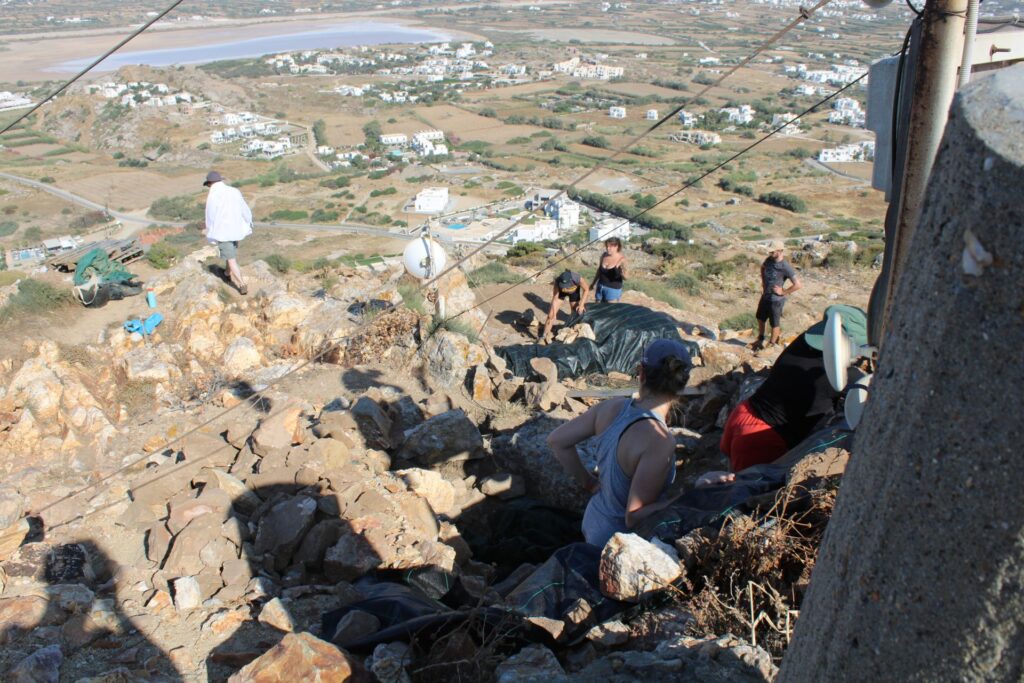
Stelida has long been written off as an agricultural wasteland; its infertile soil, exposed bedrock and windswept location meant it held practically no value to modern humans for centuries. Except for a few foreigners who settled there in the 1960s, including Alfred de Grazia, it was a deserted place.
But in the 1980s, things began to change: Investors saw the potential of its stunning views and lack of agricultural disruption. So began Stelida’s tourism boom. But while the spot now boasts some of the most exclusive properties on the island, its archaeological potential has emerged as its market value rises. The race to salvage the past before it is permanently cemented over has become more urgent than ever.
One of Stelida’s most striking features is its huge outcropping of chert, a white, workable sedimentary rock, which is visible from the sea; it stands out as a geological feature and is a rare sight in the Aegean. In 1981, archaeologists from the French School at Athens conducted a pedestrian survey there, a nonintrusive examination of the area’s surface for interesting features and exposed artifacts. The team gave tentative estimates about the age of the chipped stones and tools discovered at ground level, dating the finds to as far back as the Epipaleolithic era, between around 20,000 and 10,000 years ago.
The very suggestion that humans had been present on Naxos as far back as 20,000 years ago was unthinkable at the time. John Cherry, an influential archaeologist and prehistorian, maintained that human colonization of the Mediterranean islands did not happen until much later, around 7000 BCE, and this widely accepted theory made it hard for observations at Stelida to gain any credibility or traction. Greece and its islands remained peripheral when it came to the study of the deep past and human evolution; it would be another 30 years before the discussion would be rekindled.
Cracks in Cherry’s theory first began to appear in 2010, when the island of Crete, a former Bronze Age powerhouse and cultural epicenter, suddenly became a hot topic for archaeologists. A new, much deeper layer of its history was beginning to unfurl.
Archaeologists Thomas F. Strasser and Eleni Panagopoulou had unearthed Paleolithic artifacts across nine sites — flint handaxes, cleavers and scrapers — dating as far back as 130,000 BCE. The finds displayed characteristics of the Acheulean style, a toolmaking technique that is a suspected innovation of Homo erectus, the species from which both Neanderthals and modern humans evolved.
“What they were suggesting was a paradigm shift,” Carter says. “It forces us to rethink how we see ourselves, the difference between us and them.” The past decade of excavation at Stelida has now exposed finds that surpass the Cretan artifacts in age and make it the oldest known cultural site in the Aegean.

In 2015, the team began excavating in earnest, opening several trenches on and around Stelida, prioritizing natural terraces in the hillside where the soil would have been least disturbed. In 2017, the team submitted soil deposits for optically stimulated luminescence analysis — a technique that extrapolates information about the soil by assessing its radioactive content. A year or so down the line, the results were in: The earliest deposits were an astonishing 233,000 to 217,000 years old — at least. “These are terminus antequam dates, meaning they’re just minimum ages,” says Carter. “They could be a lot older.”
The age alone made it unlikely that these finds were the work of Homo sapiens, but there were other clues that suggested an intriguing new angle to this prehistoric story. The toolmaking displayed signs of the Levallois technology, a method which is especially (but not exclusively) characteristic of Neanderthals.
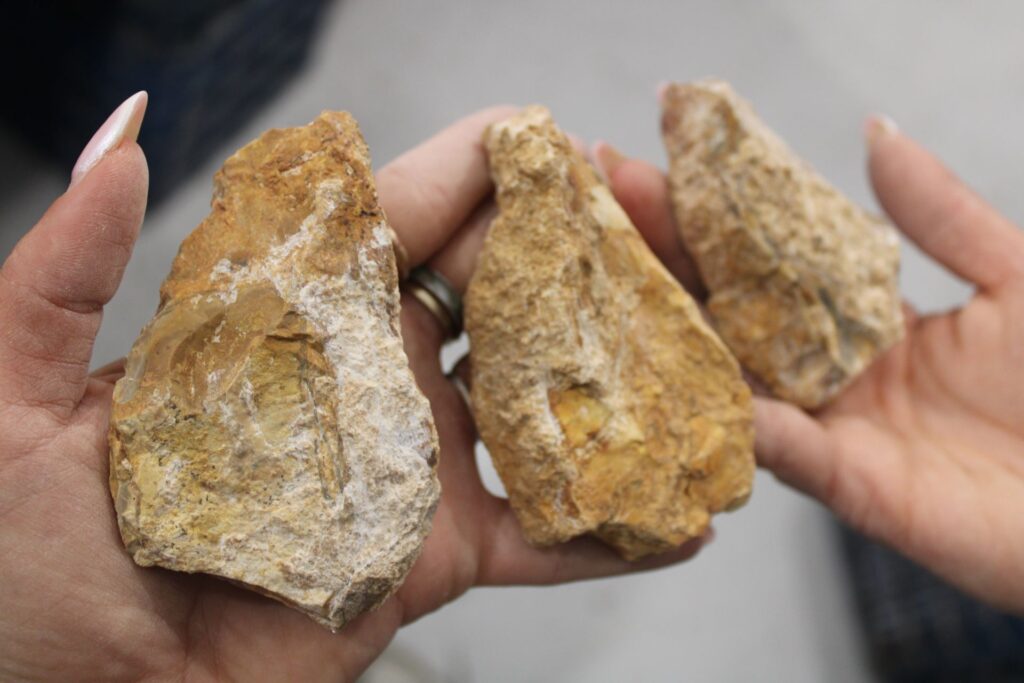
“Levallois enables you to produce very specific products,” says Danica Mihailović, a doctoral student at Belgrade University. This is because the technology involves carefully sculpting a “core,” using precise strikes to create stone flakes of a predetermined shape and size, which could be used for specific purposes — as spearheads or scrapers, for example.
Some have suggested this technique improved the efficiency and speed of toolmaking, as well as allowing for a greater uniformity of blade or flake size. “Chert is a very common material throughout the Stone Age,” Mihailović says. “It was the preferential material for knapping because it breaks in this very specific way and it’s easy to control.” Regionally, there is hardly any data with which to compare the chert tools at Stelida; the team can only look for parallels in Levallois technology farther afield — in the Levant, for instance.
“We don’t have any sites [elsewhere in Greece] with evidence of [Stelida] chert being used, but hopefully, one day, we will be able to make a connection,” Mihailović says. “I was very curious about this project from the beginning, because it’s basically the missing link between what was going on in the Middle East and Turkey, and the Aegean and Europe.”
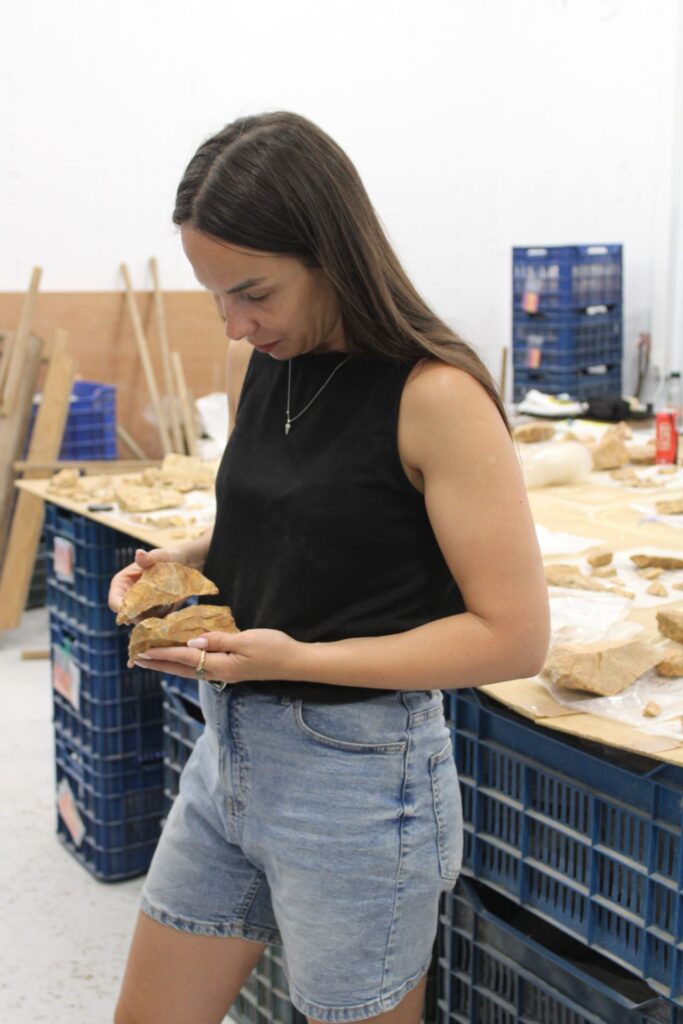
Until recently, the Aegean was considered a barrier to humans’ migration from Africa into Europe, the only viable route being the Thracian land bridge, which is in Istanbul today. But discoveries at Stelida are making different kinds of conversation possible; they represent one small piece of a puzzle that is still largely unknown to us. If humans were migrating via the Aegean in the Paleolithic era, where else might they have settled? What other sites in the region have been archaeologically neglected?
While Stelida represents the first steps toward identifying these ancient visitors, the team is somewhat limited in what it can say about who they were: The majority of the finds are offcuts, the debris of toolmaking. “It’s like excavating the factory floor after taking away all of the products,” Carter says. “We need the other half of the story.” The path to the peak is littered with thousands upon thousands of chert flakes: You cannot move for archaeology.
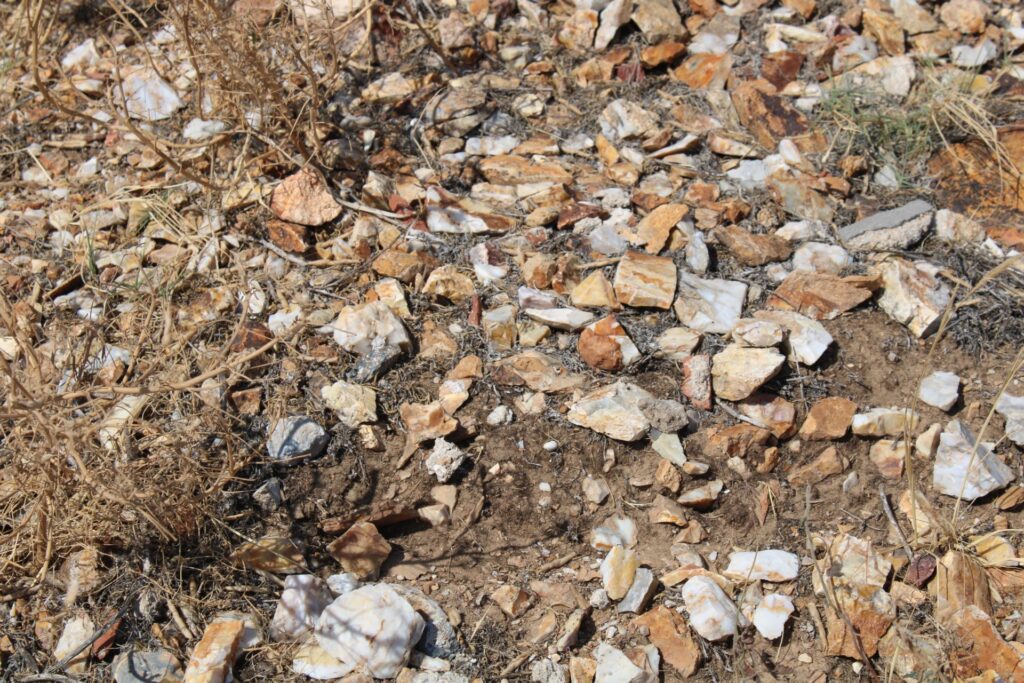
Although the team found evidence for a spring (which had run dry) and a possible rock shelter, the working theory is that Stelida was only ever used as a toolmaking site, not for permanent residence, due to the superabundance of debris over finished products. The team’s best bet would be to explore caves along Naxos’ coastline, but this in itself presents unique challenges, not least the difficulty in reconstructing the chronology of cave habitation.
Paleolithic material has reportedly been spotted along the Naxos coastline, exposed by erosion; it is also likely that any evidence of Neanderthal activity lies underwater, as the topography of the Aegean would have been very different. Previously a “mega-island” in the Lower and Middle Paleolithic era, what has now become the Cyclades island group, which includes Naxos, would have been only intermittently connected to mainland Greece and Asia Minor because of tectonic movement, according to research by archaeologist Vasilios Lykousis. Anyone wanting to reach it would have mostly had to do so by raft or boat.
If it was Neanderthals making their way across bodies of water, albeit small distances, then our assumptions about the species’ technological prowess are thrown into sharp relief. The gap between “us” and “them” begins to rapidly shrink.
“Unfortunately, a lot of prehistory is viewed in a very pragmatic way,” Carter says. “What was it the Neanderthals needed? It is all seen in terms of brutish survival rather than curiosity or from a cultural perspective.” While dwindling resources and climate may well have motivated innovation or migration, a more holistic, humanizing perception might be useful here, too.
“There’s a risk of making Neanderthals’ behavior a tad deterministic,” he says. “There’s not much agency or free thought or imagination.”
Our closest extinct ancestor, the Neanderthals have been an enduring source of intrigue ever since their first formal identification in 1848 as Homo neanderthalensis, following the discovery of a fossil in Gibraltar. But despite the many intervening years since this initial find, the portrait of the Neanderthal remains tantalizingly fragmentary. Heavy-browed, broad-nosed and brawny, the hominid has historically been viewed with derision and even reduced to an insult: the knuckle-dragging ancestor we have very little in common with.
“People come up with this checklist,” Carter says. “Only we, Homo sapiens, buried the dead; only we had language and artwork. It rapidly collapses into an archaeology of the ego.”
Dialogue has begun to shift around the Neanderthal profile in recent years, however, and that line between “us” and “them” is starting to blur. From the reductive image of the 19th and 20th centuries, not far removed from the scientific racism of the time, Neanderthals are undergoing a rebranding. Today, they are often portrayed as more sensitive than we previously imagined, incredibly adaptable to often deeply inhospitable environments and even capable of symbolism.
In 2019, a chance discovery shed an entirely new light on this fraught debate over the early years of our species. A closer look at the surrounding chert stone structures led to the realization that, in fact, the team at Stelida was not only dealing with a Paleolithic site, but a Bronze Age site, too.
Intense focus on the Paleolithic trenches and lithics had led the team to ignore the crumbling remains of a Minoan-style peak sanctuary, dating to around 1700-1600 BCE, a compelling discovery for this patch of the Cyclades, given that Naxos has historically been regarded as a cultural and political backwater of the Bronze Age. A new round of excavations followed, and soon the archaeologists were unearthing extraordinary assemblages, including hundreds of pottery shards, votive offerings such as stone ladles, and sacrificial bone fragments.

The team launched a new exhibition this year, entitled “Ariadne’s Thread.” It takes its name from the famous Greek myth about Ariadne, a Cretan princess who was abandoned by her lover Theseus on the island of Naxos, after helping him to slay the Minotaur, a treacherous half-bull, half-human beast, and then to escape its labyrinth — with a ball of thread. The exhibition drew together the strands of both the Neanderthal and Bronze Age story the team had discovered at Stelida.
“We mainly focused on thematic similarities between the periods: modern times, the Bronze Age and the Paleolithic era, they all extracted the chert for different purposes,” says Shannon Crewson, a doctoral student at McMaster University. “So, the Neanderthals used it for toolmaking, the Bronze Age people used it to make the peak sanctuary, and the modern people used it to make the airport on Naxos.”
Stelida is thought to have been a marginal, seasonal location, judging by the frequency and nature of deposits, as well as the isolated nature of the hill and its poor soil quality. Just as the Neanderthals may have only used the site for tool preparation, the team similarly suspects Bronze Age settlers would have only visited it seasonally, for ceremonial purposes.
“The Neanderthals may have eaten in the rock shelters here,” says Kristin Harper, a classicist who has excavated at Stelida for several years now. “While in the Bronze Age, they would have been coming here for ritual practices — feasting, drinking, slaughtering animals. There’s that same communal significance throughout.”
Other than the chert and clay supplies at Stelida, another one of its attractive features was, and remains, its elevation. Standing at nearly 500 feet high, the hill would have provided excellent visibility between settlements during the Bronze Age — and would equally have provided Neanderthals with the ideal hunting lookout. Today, there is an aerial beacon located on the peak.
Stelida thus appears to have had an enduring pull over the millennia, from Neanderthals all the way to modern humans. From the evidence of toolmaking, shelter and lookout posts, we are suddenly confronted with another image of ourselves. The long archaeology of this stony hilltop gives us a sense of continuity not only with prehistoric humans, but also with more distant relatives we have learned to see as “other.” Perhaps we modern humans are not so different after all, inhabiting the landscape and using its resources in similar ways to our primate relatives.
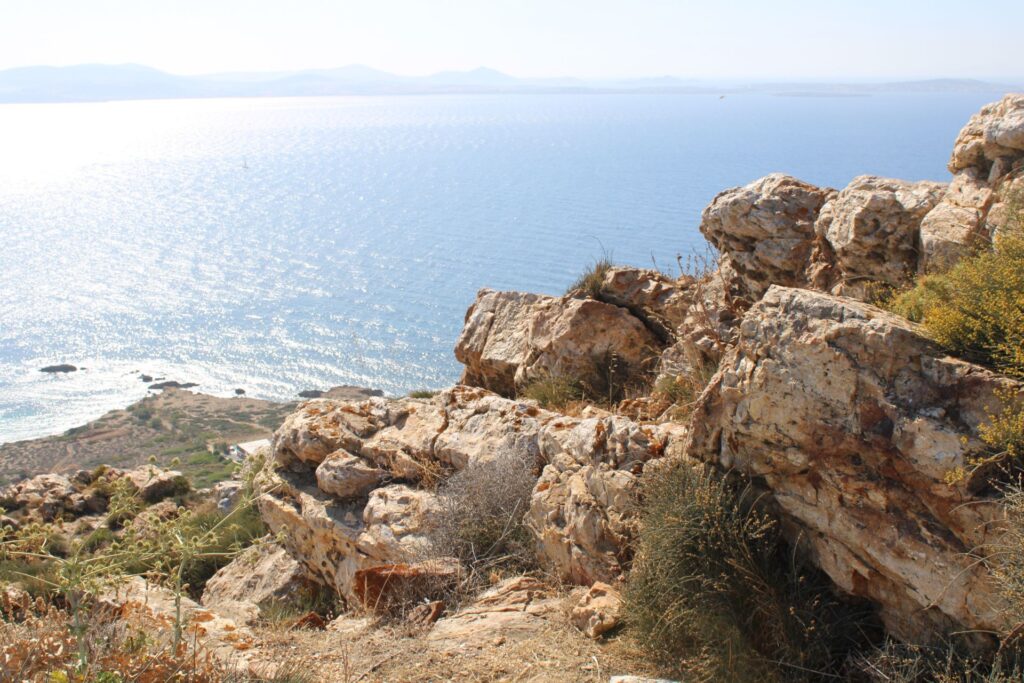
A lack of chronological nuance makes it difficult to ascertain any possible overlap in populations, but it is not too far-fetched to imagine Neanderthals and modern human groups both visiting the site intermittently and potentially coinciding.
There are precedents for this elsewhere, such as at the Mandrin Caves in France, an ongoing project led by French paleoanthropologist Ludović Slimak. Here, they have the first evidence of interstratification, layers of soil that suggest alternating Neanderthal and modern human settlements. Like Stelida, these caves appear to have been an enduring source of refuge for both populations through the ages, and they raise questions about the possibility of interaction and what this could have looked like.
We already know Neanderthals and Homo sapiens interbred. The 45,000-year-old femur of the Ust-Ishim man in Siberia, a modern human whose genetic makeup contains Neanderthal DNA, shows that the two species were comingling by roughly the time of Homo sapiens’ colonization of Europe. “Molecular biology is focusing on gene flow and which region exactly this was happening in,” Carter says. “What we are offering at Stelida is to think about spaces where they could have come together.”
Tools and the ways they were crafted offer an interesting insight into the nature of these interactions, hinting at possible knowledge exchange between the species and suggesting more complex intersocial networks. “These stone tools don’t just look like each other,” Carter says. “The very convoluted backstory of preparation and production is replicated as well. Archaeologists have been trying to move away from a simple, stylistic understanding of objects, to a deeper understanding of how things are made.”
As for the Neanderthals’ eventual extinction, there is no evidence of violence, but their disappearance does neatly coincide with our emergence in Europe and Asia. “On the face of it, we’re pretty much the smoking gun,” Carter says. Numerous theories about their demise have been floated, including the self-implosion of their small-scale communities, referring to their genetic health and the competitive edge they may have lacked in comparison to Homo sapiens’ larger, more complex groups. Or they may simply have been bred out of existence.
Of course, as with most archaeology, there are ifs and buts, with big question marks and, often, few concrete answers. Until a few years ago, it was widely accepted that modern humans did not reach Europe until around 50,000 years ago. However, this theory came under scrutiny in 2019, when Greek anthropologist Katerina Harvati reexamined a skull fragment from Apidima Cave in Greece, previously believed to be that of a Neanderthal.
Extensive CT scans and three-dimensional reconstruction of the 210,000-year-old fossil revealed its closer likeness to modern human, not Neanderthal, anatomy. The discovery, while not unchallenged, sent ripples through the archaeological world, with major repercussions for Stelida. If Homo sapiens were indeed in Greece during the Paleolithic era, could they have made their way across to Naxos? Quite possibly.
Harvati’s reappraisal is not the only complicating factor. The Levallois method, for which there is ample evidence on Stelida, is not exclusively a Neanderthal technology: Modern humans are thought to have used it, too. Signs of Aurignacian culture, modern human activity dating to between 45,000 and 25,000 years ago, have also been identified at the site, an estimate that rebuts previous theories about Homo sapiens’ colonization of the islands, believed to be a much later phenomenon. Equally, it makes it harder to rule out modern humans’ earlier Paleolithic presence on Naxos.
“The water is terribly muddy,” Carter says. “We cannot link particular techniques to either species, or know categorically who was first there. The hyperbole, that’s the aspect people get most excited about — who was the first? But the fact anyone was here at all as far back as 200,000 years is radical, in and of itself.”
This work at Naxos, long thought to be uninhabited until around 7,000 years ago, is rewriting assumptions about human — and, indeed, Neanderthal — migration, navigation and life in the Cyclades. Carter’s project has opened up huge possibilities for future work, raising as many questions as it answers, though incontrovertibly upending previous theories.
Stelida has proved itself to be a place of industry, refuge and ritual for closer to 200,000 years, holding an enduring value in its unique geology and elevation, and not just for modern humans.
Although much remains to be understood from this site, there are tantalizing leads. If Neanderthals were here, working the stone in seasonal patterns, it meant they had the craft to build rafts and to cross from the mainland to Naxos, not once, but regularly. This shatters the brutish image we have held of these hominins, as a species shackled by primal instincts and the whims of nature.
The archaeology at Stelida introduces another dimension to the picture: that Neanderthals were, in fact, driven by something a lot more human. The discoveries hint at a deeper truth about our similarities and shared connection to this world, and the project at Stelida may well lead to a more nuanced and more humble reappraisal of what it means to be human.
Become a member today to receive access to all our paywalled essays and the best of New Lines delivered to your inbox through our newsletters.



